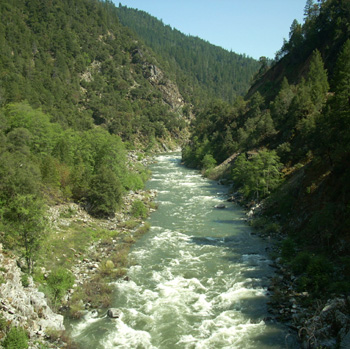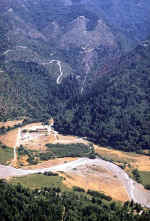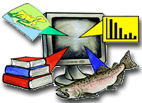Bibliography Background About KRIS
Stream Flow
 Stream flow, or discharge, is the volume of water flowing in a stream channel expressed as unit per time (cfs = cubic feet per second). Stream flow is an important determinant of water quality and aquatic habitat conditions. High water temperature, low levels of dissolved oxygen, and deleterious levels of toxins can all be exacerbated by low stream flow. Moreover, the quantity, quality and connectivity (e.g. fish migration) of aquatic habitats are also influenced by flow. Agricultural and domestic water diversions are common sources of impact to aquatic resources. Diversions and associated diking, damming, and dredging are a large contributing factor to the loss of salmon and steelhead habitat in some river basins (Beechie et al. 1994, McBain and Trush, 1997).
Stream flow, or discharge, is the volume of water flowing in a stream channel expressed as unit per time (cfs = cubic feet per second). Stream flow is an important determinant of water quality and aquatic habitat conditions. High water temperature, low levels of dissolved oxygen, and deleterious levels of toxins can all be exacerbated by low stream flow. Moreover, the quantity, quality and connectivity (e.g. fish migration) of aquatic habitats are also influenced by flow. Agricultural and domestic water diversions are common sources of impact to aquatic resources. Diversions and associated diking, damming, and dredging are a large contributing factor to the loss of salmon and steelhead habitat in some river basins (Beechie et al. 1994, McBain and Trush, 1997).
Stream flow is also a powerful determinant of aquatic habitat conditions through the effects of peak or flood events. All coastal watersheds of northern California exhibit, as a function of climate, highly variable and unpredictable stream flows during winter months. Only the highest 5% of the range of flows cause enough deposition and scour to significantly alter stream morphology. (Leopold 1994). It is during these flood flows that banks are either built or eroded, pools are deepened or filled, and large wood is contributed and redistributed. It is also during these flood flows that very high rates of mortality occur for salmonids in the egg or alevin life stage (McHenry et al. 1994). Photo is of the Scott River at flood in December 1964.
 Changes in vegetation, such as extensive clear cutting, can increase the frequency and intensity of flood flows due to accelerated runoff. Zeimer (1998) found a 35% increase in mean peak flows after logging of the North Fork of Caspar Creek. While this effect disappears with forest stand recovery, urbanization has a more profound effect on peak flows because impervious surfaces increase (May et al., 1996). Both removal of vegetation and urbanization decrease the lowest flows by reducing the water storage capacity of watershed soils. The picture at left shows Terwer Creek on the lower Klamath River where bed aggradation is so great that the stream loses surface flows in summer.
Changes in vegetation, such as extensive clear cutting, can increase the frequency and intensity of flood flows due to accelerated runoff. Zeimer (1998) found a 35% increase in mean peak flows after logging of the North Fork of Caspar Creek. While this effect disappears with forest stand recovery, urbanization has a more profound effect on peak flows because impervious surfaces increase (May et al., 1996). Both removal of vegetation and urbanization decrease the lowest flows by reducing the water storage capacity of watershed soils. The picture at left shows Terwer Creek on the lower Klamath River where bed aggradation is so great that the stream loses surface flows in summer.
References
Beechie T. J., E. Beamer, and L. Wasserman. 1994. Estimating coho salmon rearing habitat and smolt production losses in a large river basin, and implications for habitat restoration. North American Journal of Fisheries Management. 14( 4): 797- 811.
Leopold, L.B. 1994. A View of the River. Harvard University Press.
May, C., C. Cooper, R. Horner, J. Karr, B. Mar, E. Welch, and A. Wydzga. 1996. Assessment of Cumulative Effects of Urbanization of Small Streams in the Puget Sound Lowland Ecoregion. A paper presented at the Urban Streams Conference held at Arcata, CA on November 15-17, 1996.
McBain and Trush. 1997. Trinity River Flow Maintenance Study. Performed under contract to the Hoopa Tribe. Contract #30255. McBain and Trush, Arcata, CA. 481 pp.
McHenry, M.L., D.C. Morrill, and E. Currence. 1994. Spawning Gravel Quality, Watershed Characteristics and Early Life History Survival of Coho Salmon and Steelhead in Five North Olympic Peninsula Watersheds. Port Angeles, WA. 59 pp. without appendices. [860k]
Ziemer, R.R. 1998. Flooding and stormflows. In Ziemer, R.R., technical coordinator. Proceedings of the conference on coastal watersheds: the Caspar Creek story. May 6, 1998; Ukiah, CA. Technical Report PSW-GTR-168. Albany, CA: Pacific Southwest Research Station, USDA Forest Service; 15-24
